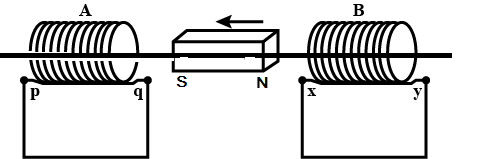
The direction of induced current in the coils A and B in the situation shown in the figure is then:

A) p to q in coil A and x to y in coil B
B) q to p in coil A and x to y in coil B
C) p to q in coil A and y to x in coil B
D) q to p in coil A and y to x in coil B
Answer
142.8k+ views
Hint: A current can be induced in a current loop if it is exposed to a changing magnetic field. Induced current always opposes the cause of it according to Lenz's law.
Complete step by step solution: The direction of the current can be determined by considering Lenz's law, which states that an induced electric current will flow in such a way that it creates a magnetic field that resists change in the field it produces. In other words, if the applied magnetic field continues to increase, the current flowing in the wire will flow in such a way that the magnetic field generated around the wire will decrease the applied magnetic field.
Here in the given figure In coil A, the south pole develops in Q and in coil B also the south pole develops in X. Thus, the current flowing in coil A will be from Q to P and the current flowing in coil B will be from x to y.
Additional Information: In 1831, Michael Faraday conducted several experiments in an attempt to prove that electricity could be produced by magnetism. Within a few weeks, the great experimenter not only explicitly demonstrated this phenomenon, now known as electromagnetic induction.
Note: A current can be induced in conducting loop,If it comes in contact with a changed magnetic field, This change can happen in a variety of ways; You can change the strength of the magnetic field, move the conductor in and out of the field, change the distance between the magnet and the conductor, or change the field of the loop located in a constant magnetic field. Considering how the variant is obtained, the result, the transmitted current, is the same.
Complete step by step solution: The direction of the current can be determined by considering Lenz's law, which states that an induced electric current will flow in such a way that it creates a magnetic field that resists change in the field it produces. In other words, if the applied magnetic field continues to increase, the current flowing in the wire will flow in such a way that the magnetic field generated around the wire will decrease the applied magnetic field.
Here in the given figure In coil A, the south pole develops in Q and in coil B also the south pole develops in X. Thus, the current flowing in coil A will be from Q to P and the current flowing in coil B will be from x to y.
Additional Information: In 1831, Michael Faraday conducted several experiments in an attempt to prove that electricity could be produced by magnetism. Within a few weeks, the great experimenter not only explicitly demonstrated this phenomenon, now known as electromagnetic induction.
Note: A current can be induced in conducting loop,If it comes in contact with a changed magnetic field, This change can happen in a variety of ways; You can change the strength of the magnetic field, move the conductor in and out of the field, change the distance between the magnet and the conductor, or change the field of the loop located in a constant magnetic field. Considering how the variant is obtained, the result, the transmitted current, is the same.
Recently Updated Pages
How to find Oxidation Number - Important Concepts for JEE

How Electromagnetic Waves are Formed - Important Concepts for JEE

Electrical Resistance - Important Concepts and Tips for JEE

Average Atomic Mass - Important Concepts and Tips for JEE

Chemical Equation - Important Concepts and Tips for JEE

Concept of CP and CV of Gas - Important Concepts and Tips for JEE

Trending doubts
JEE Main 2025 Session 2: Application Form (Out), Exam Dates (Released), Eligibility, & More

JEE Main Exam Marking Scheme: Detailed Breakdown of Marks and Negative Marking

JEE Main 2025: Derivation of Equation of Trajectory in Physics

Electric Field Due to Uniformly Charged Ring for JEE Main 2025 - Formula and Derivation

Electric field due to uniformly charged sphere class 12 physics JEE_Main

Degree of Dissociation and Its Formula With Solved Example for JEE

Other Pages
JEE Advanced Marks vs Ranks 2025: Understanding Category-wise Qualifying Marks and Previous Year Cut-offs

JEE Advanced 2025: Dates, Registration, Syllabus, Eligibility Criteria and More

JEE Advanced Weightage 2025 Chapter-Wise for Physics, Maths and Chemistry

Dual Nature of Radiation and Matter Class 12 Notes: CBSE Physics Chapter 11

Formula for number of images formed by two plane mirrors class 12 physics JEE_Main

Electrical Field of Charged Spherical Shell - JEE




